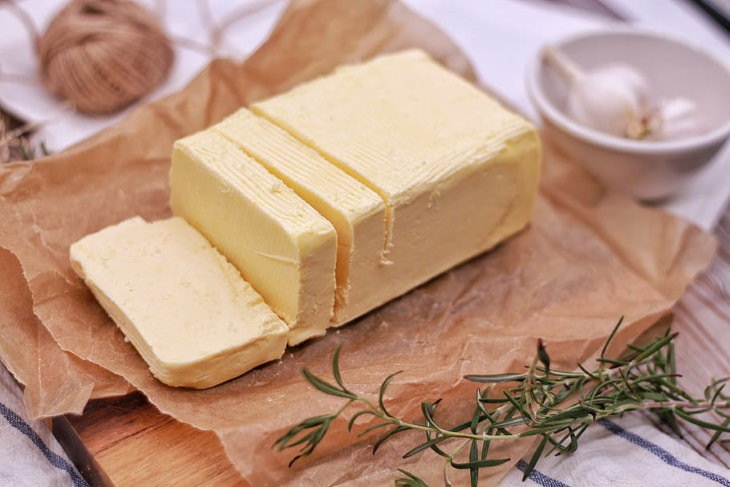What is the difference between the two?
Although both butter and margarine are fat-based spreads and can be quite similar in appearance, they are two completely different products. Butter is made by churning cow’s milk or cream, whereas margarine is created by mixing plant fats with emulsifying agents to form a thick spread. Sometimes, brands can also mix together butter and margarine to bring down the cost of butter.
Due to this essential difference in the basic ingredients, butter and margarine also differ in terms of their taste and consistency. Unlike butter, margarine comes with a variety of fat content ranging from 10-90%, so by far not every margarine variety will be capable of replacing butter in the kitchen. For example, low-fat margarine is not considered good for baking because it lacks the creamy texture and rich flavor of butter.
Apart from these superfluous differences, butter and margarine also have distinct effects on our health, especially heart health, which we discuss below.
The Health Benefits and Risks of Butter
As previously mentioned, about half a decade ago, in the 1970s, medical research had found that people who consumed a lot of butter were more likely to suffer from obesity and heart disease, so doctors started recommending margarine instead of butter. The ingredients blamed for the negative health effects were saturated fats, and ordinary butter is comprised of about 50% of these fats.
As a result, health authorities started warning people about the dangers of saturated fats for decades. However, more recent investigations have found more mixed results. While the majority of modern research still maintains that eating a lot of butter isn’t good for you since its fattening, research from the past 5 years finds little to no difference in blood lipid and other inflammation markers in participants who consume moderate amounts of butter compared to those who replace it with margarine.
Thus, many nutritionists and medical researchers today actually maintain that saturated fat isn’t a cause for concern. One reason to still not indulge in too much butter, though, lies in its cholesterol content. Like saturated fats, cholesterol used to be demonized in the past, but more recent accounts assure that moderate amounts of cholesterol pose little to no danger for your heart health.
What’s more, nutrition experts now say that butter may offer some health benefits, such as the rare vitamin K2 that’s associated with the prevention of many diseases, including cancer, as well as many beneficial fats that are difficult to get from other sources, such as omega-3 fats, butyrate, and conjugated linoleic acid. Experts also note that grass-fed butter is richer in these beneficial nutrients.
What About Margarine?
Margarine was initially invented in late 19th century France as a cheaper alternative to butter, but it didn’t gain a lot of popularity before the 1970s when the mass anti-butter movement started. Researchers claimed that, unlike the saturated-fat-rich butter, margarine is rich in polyunsaturated fats derived from soybean oil or a different type of plant oil.
Polyunsaturated fats are suggested to be able of lowering blood markers that contribute to heart disease. Indeed, one study researching the difference between saturated and polyunsaturated fats found a 17% reduced risk of heart disease, but no actual difference in mortality rates.
That said, not all types of polyunsaturated fats are considered healthy - omega-6 fats can lead to an increased risk of obesity, heart disease, and inflammatory bowel disease if consumed in excess. It’s important to maintain a balance between omega-6 and omega-3 fats to prevent these diseases.

In addition, many margarine varieties, especially the low-fat ones, contain another type of fat - trans fats - that have been proven to be much worse than saturated fats, as they both lower the levels of good cholesterol and increase the levels of bad cholesterol, which dramatically increases one’s risk of heart disease.
Today, both doctors and nutrition experts agree that we ought to avoid trans fats completely, but many margarine varieties still contain it. You can check whether or not any food type, not only margarine, contains trans fats by checking the nutrition label on the packaging. Brands are required by FDA regulations (and most other regulatory authorities worldwide) to disclose all the major fats their products contain, including saturated and trans fats. Alternatively, look for the word “hydrogenated” in the ingredients list of a product to spot an ingredient that may contain trans fats.
In summary, butter is not a bad food many people make it out to be if consumed in small quantities. It’s best to opt for grass-fed butter that’s richer in healthy fats and vitamins. Margarine, on the other hand, is likewise safe for you to eat in moderation as long as it doesn’t contain trans fats. That said, moderation is key, and it’s best if you replace both butter and margarine with olive oil or other healthy oil varieties whenever possible to keep your cardiovascular system healthy.
Share this article with everyone who's interested in nutrition and health!
 Go to BabaMail
Go to BabaMail



























